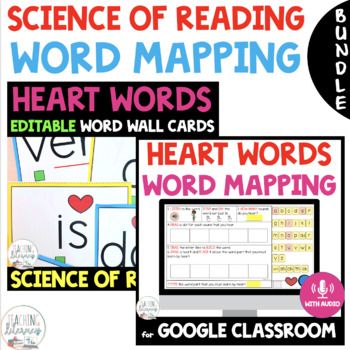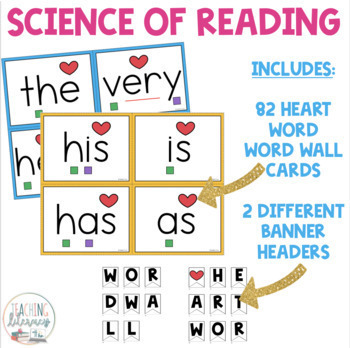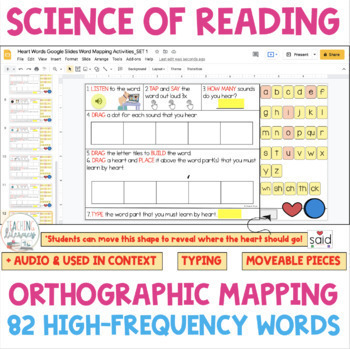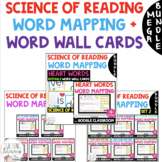HEART WORDS | Word Wall | Word Mapping for Google Classroom | Science of Reading
- Zip
- Google Apps™
- Internet Activities

What educators are saying
Products in this Bundle (2)
Also included in
- Save time and money with this ❤️ HEART WORDS ❤️ & FLASH WORDS HIGH FREQUENCY Science of Reading MEGA BUNDLE!Are you looking for an interactive, digital way to practice sight word mapping that aligns with the Science of Reading?Then, this paperless Google Slides™ resource is for you!In the past, hiPrice $32.00Original Price $40.00Save $8.00
Description
Save time and money with this Science of Reading BUNDLE!
Are you looking for eye-catching high frequency ❤️ HEART WORD ❤️ cards for your sound/word wall as well as an interactive, digital way to practice sight word mapping that aligns with the Science of Reading?
Then, this resource is for you!
The Science of Reading has brought about a change in the way educators approach high-frequency word instruction.
It is now recognized that high-frequency words can be split into two categories: decodable (“Flash Words”) and irregular (“Heart Words”).
- Decodable Flash Words are expected to be read and spelled automatically - “in a flash.”
- Irregular Heart Words have a word part that cannot be read phonetically; that word part must be learned by “heart.”
82 words (37%) on the Dolch 220 List are Heart Words. That list can be split into words that can (45 words) and cannot (37 words) be grouped by similar spelling patterns.
Some high-frequency words may start out as Heart Words but turn into Flash Words once the respective spelling pattern/rule has been taught. The words in this resource will most likely remain Heart Words for some time, depending on the scope and sequence of your phonics program.
ABOUT THE WORD WALL RESOURCE:
- Every Heart Word card has a colored box under each individual phoneme
- A red heart is placed above the irregular word part(s) that readers must learn by “heart”
WHAT YOU GET WITH THE WORD WALL RESOURCE:
- 82 HEART WORD cards (approx. 4” x 5” each)
- 2 different BANNER HEADERS
- an EDITABLE HEART WORD CARD TEMPLATE (you must have PowerPoint; font is not included)
- a list of Heart Words grouped by similar spelling patterns
- a list of Heart Words that do not follow a spelling pattern
WITH THE GOOGLE SLIDES RESOURCE, STUDENTS HAVE TO:
- listen to an audio recording of a Heart Word used in context
- tap and say the word 3xs
- type the number of sounds they hear in the word
- drag a dot into a sound box for each sound that they hear
- build the word using letter tiles
- place a heart above the tricky word part
- type the tricky word part
WHAT YOU GET WITH THE GOOGLE SLIDES RESOURCE:
- 82 HEART WORD word mapping interactive Google Slides, with audio
- a self-checking feature where students move a shape to reveal where the heart should go
- a list of 45 HEART WORDS grouped by spelling pattern
- a list of 37 HEART WORDS that do not follow a spelling pattern
- Student Data Tracker Sheets
- Pre and Post Assessments & Recording Sheets
- Pre and Post Spelling Assessment Paper
WAYS TO USE THE GOOGLE SLIDES RESOURCE:
- During morning work
- As Do Nows
- For homework
- As part of your Reading Workshop or Reading Centers
- As formative or summative assessments
- As whole class practice via a SmartBoard
82 HEART WORDS INCLUDED:
his; is; as; has; have; give; live; some; come; done; to; do; into; there; where; those; these; all; call; fall; small; could; would; were; are; old; cold; hold; both; find; kind; mind; once; once; want; wash; blue; put; full; pull; walk; any; many; too; work; buy; the; very; here; does; use; a; yours; two; goes; carry; of; from; again; write; because; you; don’t; who; always; together; was; know; been; only; please; said; pretty; eight; our; shall; they; four; today; warm; laugh; what; their
** This DIGITAL resource requires Google Slides. Purchasing this resource will give you PDFs to download, which include hyperlinks to access the digital resource. You and your students must have a Google™ account in order to use this resource.
PREFER A version with EDITABLE PDFs? Click here.
CLICK HERE for more SCIENCE OF READING resources!
Rating after downloading is greatly appreciated.
Yours in Literacy,
Sheila ☺
© Google and Google Apps are registered trademarks of Google Inc.






